1. Introduction
Beef cow-calf extensive systems in Uruguay, highly dependent on native pastures belonging to the Pampa biome, have historically recorded low weaning rates and calf weaning weight at 180 days old. The combination of early weaning of calves at 60-90 days old followed by lot-feeding the animals with high-concentrate rations during 90 to 100 days was shown to significantly improve the pregnancy rate in first-calf heifers and cows in poor body condition, simultaneously increasing calf weight for sale compared with lactating calves, all of which result in an overall improvement in system productivity1.
Protein requirements for the expression of growth potential are highest in young cattle compared with more advanced development stages2. With the most commonly used diets (200 g/kg roughage and 800 g/kg concentrate) formulated based on ground corn grain and soybean meal, the optimal performance of calves was obtained with a crude protein concentration in the ration of 175 to 180 g/kg, achieving maximum growth rates of around 1.2-1.3 kg/d and a gain efficiency of 239 g/kg3. Replacing corn with sorghum grain to reduce feed cost resulted in a 15% reduction in gain efficiency and a linear response to even higher levels of protein in the diet4. Changing the energy and protein sources in the ration by partially replacing sorghum grain and soybean meal with distiller grains (DG) could improve gain efficiency while reducing feed cost.
Distillers' grains hold high nutritional value. As a result of cereal starch removal during the fermentation process for ethanol production, an approximate threefold increase in digestible fiber, protein, and fat content occurs in the DG compared with the grain of origin5. For the early-weaned calf, DG would result a safe feed in terms of risk of acidosis and a good source of rumen undegradable protein6.
Replacing corn grain (dry rolled or high moisture) with graded levels of dry DG plus solubles in finishing diets improves gain efficiency, although variation is observed regarding the optimal inclusion level. A meta-analysis of five experiments reported by Klopfenstein and others7 showed a quadratic response in BW gain and a cubic response in gain efficiency as dry DG increased up to 400 g/kg in the ration, with optimal performance when DG represented 100 to 200 g/kg. However, Bremer and others8 reported a linear increase in gain efficiency and a constant 112% feeding value for dry corn DG included in up to 400 g/kg of the diet, based on a meta-analysis of four experiments evaluating the use of dry DG in feedlot finishing diets.
The type of grain used during the fermentation process may affect the chemical composition of DG2. Compared with corn DG, the feeding value for sorghum wet DG derived from gain efficiency has been reported to be 10 to 40% lower 9)(10) 11. Therefore, when predicting performance based on DG inclusion level, it is likely that the rate of sorghum DG that optimizes animal response will differ from that of corn DG.
In the literature, studies that evaluate DG from sorghum for replacing sorghum grain are quite limited compared with those that use corn as primary grain in the diet; furthermore, to the best of our knowledge, no studies have evaluated its use with early-weaned calves. In terms of gain efficiency, the observed response to increasing levels of sorghum DG in the diet, replacing sorghum grain up to 450 g/kg in the ration (dry matter (DM) basis), has differed between wintered-growing 10-month-old calves12 and finishing cattle 13)(14) , probably as a consequence of the change in metabolizable protein and energy requirements as the animals grow.
Regarding decision making in the use of sorghum DG with early-weaned calves, it is relevant to develop quantitative response curves for animal performance and gain efficiency as the DG replace sorghum and soybean meal in the ration. We hypothesized that the feeding value of the diet will vary depending on sorghum dry DG inclusion level in the ration, with an optimum that maximizes the gain efficiency of the calves. This would possibly be associated with a higher contribution of non-degradable protein in the rumen compared with that provided by the mixture of sorghum grain and soybean meal, as well as with a reduction in nonfibrous carbohydrates, as starch from sorghum grain is replaced by digestible fiber and fat from the DG. Therefore, this study’s objective was to evaluate the effect of graded levels of sorghum dry DG plus solubles (SDDGS; 0, 130, 260, or 390 g/kg, DM basis) on growth and gain efficiency of early-weaned calves as well as on diet NE supply.
2. Materials and methods
Procedures involving animal care and management followed the recommendations and general principles established by the Regulations on the Use of Animals in Experimentation (Honorary Commission for Animal Experimentation, Universidad de la República, Uruguay).
2.1 Animals, treatments and management
Twenty-four early-weaned castrated Hereford calves (84.6 ± 11.0 kg) were used in a 70-d growing trial (January 26 through April 4, 2016), at the Mario A. Cassinoni Experimental Station of the Agronomy School (58°02′W, 32°22′S). Calves coming from the experimental cow-calf herd were randomly assigned to individual semi-roofed pens (9 m2/animal) and to four experimental rations that differed in SDDGS content: 0 g/kg (DG0), 130 g/kg (DG13), 260 g/kg (DG26), or 390 g/kg (DG39) on a DM basis (six calves/ treatment). Rations were formulated to have a similar supply of metabolizable energy (ME) and crude protein (CP) by replacing a mixture of sorghum grain (420 g/kg) and soybean meal (580 g/kg) as SDDGS was increased (Table 1). The composition of the SDDGS was 298.0 g/kg CP, 505.5 g/kg aNDFom, 215.1 g/kg ADFom, and 139.1 g/kg fats (DM basis), and were supplied by a local plant in a single batch at the beginning of the study.
Table 1: Ingredients and chemical composition of experimental rations varying in sorghum dry distillers’ grains plus soluble (DG) concentration
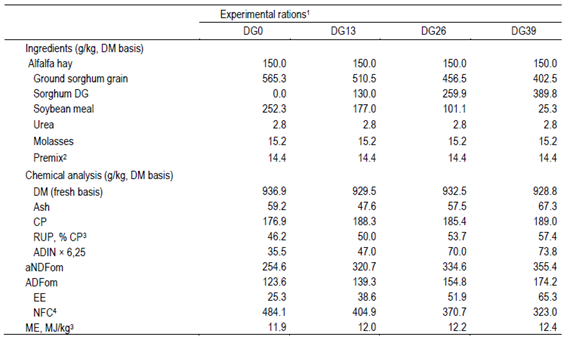
ADIN: acid insoluble nitrogen; ADFom: acid detergent fiber, sodium sulphite, corrected for ash contamination; aNDFom: neutral detergent fiber using α-amylase, sodium sulphite, corrected for ash contamination; CP: crude protein; DM: dry matter; EE: ether extract; ME: metabolizable energy, RUP: rumen undegradable protein. 1Concentration of sorghum DG in the diet: 0 (DG0), 130 (DG13), 260 (DG26) or 390 (DG39) g/kg (DM basis). 2Premix composition: CaCO3 526.3 g/kg, Zoodry feedlot (mineral - vitamins) 131.6 g/kg, NaCl 263.2 g/kg, Rumensin (20% monensin) 13.1 g/kg, live yeast 65.8 g/kg (DM basis). 3Calculated based on tabular values of ingredients6. 4Nonfibrous carbohydrates NFC= 100- (ash + crude protein + fat + NDF)18
At weaning, 15 days before the experiment began calves were 61.6 ± 11.5 days old and weighed 80.4 ± 11.4 kg, and received preventive sanitary treatment against respiratory diseases, diarrhea, and ecto- and endo-parasites. Transition to solid diet intake occurred during the first 7 days following the protocol described by Simeone and Beretta15 using the DG0 ration and group feeding. By the end of this period, the calves were eating 2.5 kg of DM/100 kg body weight (BW) and were moved to the experimental facilities. During the next 8 days, the calves underwent a gradual transition to their respective experimental rations while the food supply was increased until ad libitum intake was reached. During the experimental period, feed was distributed in three equal meals (at 0700, 1200, and 1700 h) and adjusted through bunk lecture for a residual of at least 50 g/kg. Refusals were discarded after being weighed.
2.2 Data and sample collection
Animals were weighed at the beginning of the experiment and every 14 days during the experimental period, without fasting, always before their first meal. Hip height16 was also measured on day 1 and at the end of the feeding period. Offered food and refusals were weighed fresh daily for DM intake (DMI) estimation, while samples of ingredients and of individual feed refusals were taken weekly for DM determination. Samples were dried in an air-forced oven at 55°C, ground to pass a 1-mm piece of mesh, and preserved for chemical analyses. The animal behavior was assessed during daylight (0700 to 1900 h), recorded every 15 minutes through direct observation of whether individual calves were eating, ruminating, idling, or drinking water12. Observations were conducted on two consecutive days in weeks 6 and 10. Apparent DM digestibility was assessed in week 7. Total fecal production was collected on 3 days (day 44 through day 46) directly from the floor three times per day and weighed fresh12. Each day a subsample per pen (approximately 300 g) was reserved for DM content determination. Feed and refusals were sampled daily for DM determination and the characterization of particle size distribution. The latter was performed using the Penn State Particle Separator (with three sieves: 19.0, 8.0, and 1.18 mm, and a bottom pan)17. The physically effective NDF (peNDF) of the experimental diets was determined according to Mertens18 as the product between the physical effectiveness factor (pef) and feed NDF concentration, where pef represents the proportion of the whole sample (DM basis) retained above the three sieves (particle size > 1.18 mm).
2.3 Chemical analyses
Weekly samples of feed and refusals were composited by treatment and analyzed for DM (method 934.01), organic matter (OM; method 942.05), CP (N×6.25; method 984.13), ether extract (EE; method 920.39)19, acid detergent insoluble nitrogen (ADIN), neutral detergent fiber using stable α-amylase and correcting for ash contamination (aNDFom), and acid detergent fiber (ADFom)20. Non-fibrous carbohydrate (NFC) concentration was calculated by difference (NFC = 100 - ash − CP - NDF - EE)18.
2.4 Calculation
The gain-to-feed (GF) ratio for each animal was calculated as the quotient between mean daily BW gain and mean DMI, with BW gain estimated as the slope of the regression of shrunk BW on experimental days. A shrink factor of 0.96 was applied to BW data to adjust for a 4% gastrointestinal fill6. Actual intakes of OM, CP, EE, NDF, ADF, and NFC were calculated according to the following equation:
where Yi corresponds to each nutritional faction. Coefficients of apparent DM digestibility were calculated as DMD = (DMI, kg/d − fecal production, kg/d)/ DMI, kg/d. The net energy concentrations for gain (NEg) and maintenance (NEm) for the experimental diets were calculated based on observed animal performance and intake, as described by Zinn and Shen21, estimating energy requirements for maintenance (EM (MJ/d) = (.077BW0.75) 4.184) and for BW gain (EG (MJ/d) = (.0557BW.75).(BWgain1.097) 4.184) according to NRC22.
2.5 Statistical analyses
The experimental data were analyzed according to a complete randomized plot design, using de Mixed Procedure of SAS (SAS Inst. Inc., Cary, NC). Model statement included treatment fixed effect (T), and for variables with repeated measurements over time the fixed effects of week (W), day-within-week (D), and their two-way interactions (T×W and T×D) were added. Animal behavior data were analyzed through a generalized linear model, assuming a nominal multinomial distribution of the different activities and including the generalized LOGIT as the link function. The repeated measures were modeled using an autoregressive-1 covariance structure. Linear and quadratic responses to the SDDGS level in the diet were tested through orthogonal polynomials, and when a significant contrast was observed, the respective equation was estimated. Behavioral data was reported as the probability of occurrence of the different activities, and comparisons between means were made using a Tukey-Kramer test.
3. Results
3.1 Diet, intake, apparent digestibility, and behavior
Increasing levels of SDDGS in the diet resulted in a linear increase in the supply of peNDF, as the consequence of a higher NDF concentration in the diet (Table 1) without any variation in the physical effectiveness factor (Table 2).
Table 2: Particle size, effective fiber supply and animal behavior of early-weaned Hereford calves when varying sorghum dry distillers’ grain plus soluble (DG) concentration in the experimental rations
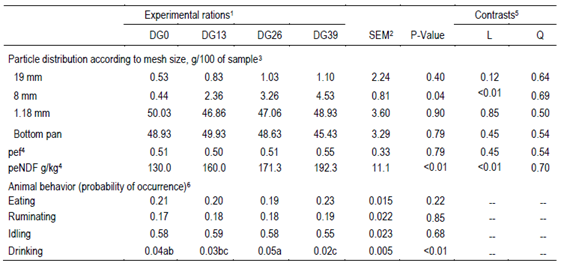
1Concentration of sorghum DG in the diet: 0 (DG0), 130 (DG13), 260 (DG26) or 390 (DG39) g/kg (DM basis). 2SEM: standard error of the mean. 3Percentage of sample weight retained on different size mesh of the Penn State particle separator17. 4pef: physical effectiveness factor (proportion of particle size >1.18 mm); peNDF: physical effective fiber= NDF (g/kg) × pef18. 5L, Q: linear and quadratic effect of sorghum DG level (x, %). Particle size (PS): PS8 mm = 0.1013x + 0.672 (R² = 0.98); peNDF g/kg = 1.5246x + 133.67 (R² = 0.97). 6Means followed by different letter differ P≤0.05 (Tukey -test).
Daily DMI (kg/100 kg BW) increased linearly with SDDGS level (P<0.01, Table 3). This was the result of a differential behavior along the experimental period, varying the response in DMI to feeding treatment depending on the week (T×W, P<0.01). Calves fed DG0 exhibited a significantly lower DMI up to week 3 compared with those eating SDDGS, which did not differ between them (2.82 vs. 3.37 kg/ 100 kg BW, P<0.05). From week 3 on, although DG39 always exhibited the highest DMI, no differences were observed due to SDDGS (Figure 1). Between-day variation in DMI was also observed (coefficient of variation was 3.98%, P<0.01), but this effect was independent of dietary treatment (T×D, P>0.05). Mean intake (kg/d) of fat, NDF, and ADF also increased linearly with SDDGS level in the ration (P<0.01), while NFC decreased linearly (P<0.01). No treatment effects (P>0.10) were observed on CP intake (0.87 ± 0.06 kg/d), apparent DMD coefficient (0.81 ± 0.03), or digestible DMI (3.6 ± 0.43 kg/d; Table 3).
Diet composition affected calves’ drinking activity (P<0.01) but had no effect on the other components of animal behavior. Table 2 reveals that the calves spent most of the daytime at rest followed by eating and ruminating (probability: 0.58, 0.21, and 0.18, respectively). Although significant week and day-within-week effects were observed for all variables (P<0.01), the response to SDDGS level in the diet was independent of these effects (T×W and T×D, P>0.05).
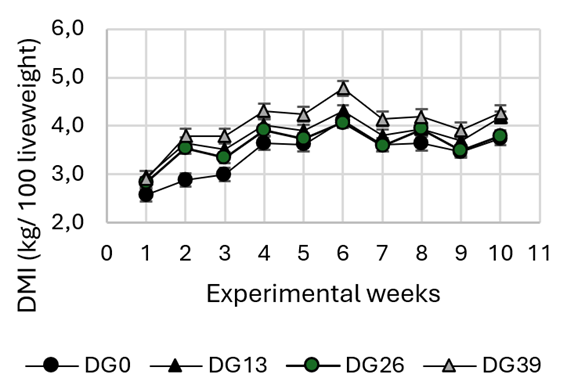
Figure 1: Effects of sorghum dry distillers’ grain plus soluble (DG) level in the diet (0, 130, 260 or 390 g/kg) on early-weaned Hereford calves' mean week daily dry matter intake (DMI)
Table 3: Intake and apparent dry matter digestibility of early-weaned Hereford calves fed a total mixed ration varying in sorghum dry distillers’ grain plus soluble (DG) concentration
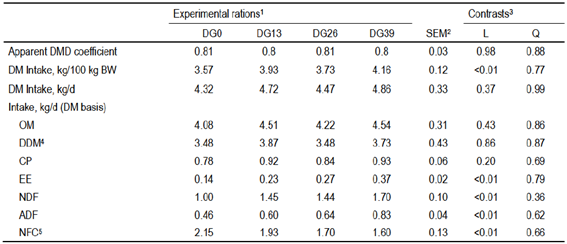
ADF: acid detergent fiber; DDM: digestible dry matter; DMD: dry matter digestibility; CP: crude protein; EE: ether extract; NDF: neutral detergent fiber; NFC: non-fibrous carbohydrates; OM: organic matter. 1Concentration of sorghum DG in the diet: 0 (DG0), 130 (DG13), 260 (DG26) or 390 (DG39) g/kg (DM basis). 2SEM: standard error of the mean. 3L, Q: linear and quadratic effect of sorghum DG level (x, %): DM intake, kg/100 kg BW = 0.0121x + 3.612 (R² = 0.63); CP intake, kg/d = 0.0043x + 0.8073 (R² = 0.68); NDF intake, kg/d = 0.0191x + 1.0757 (R² = 0.90); ADF intake, kg/d = 0.0099x + 0.459 (R² = 0.96); EE intake = 0.0054x + 0.1477 (R² = 0.98); NFC = -0.0014x + 2.127 (R² = 0.98). 4DDM = Dry matter intake × digestibility coefficient. 5NFC= 100- (ash + crude protein + fat + NDF)18
3.2 Animal performance
Animal growth did not vary due to treatments. No differences were observed in BW gain (1.12 kg/d, SE 0.05), final BW (159.5 kg, SE 8.8), or hip height (99.9 cm, SE 1.9) as SDDGS replaced sorghum grain and soybean meal in the diet; however, the GF ratio decreased linearly (P<0.01), exhibiting a variation of −12 g for every 100 g of increase in the content of SDDGS in the ration. Observed NEm and NEg concentrations of the experimental diets exhibited the same negative linear response (Table 4).
Table 4: Effects of sorghum dry distillers’ grain plus soluble (SDDGS) level in the diet on early-weaned Hereford calves' performance and diet net energy (NE) concentration
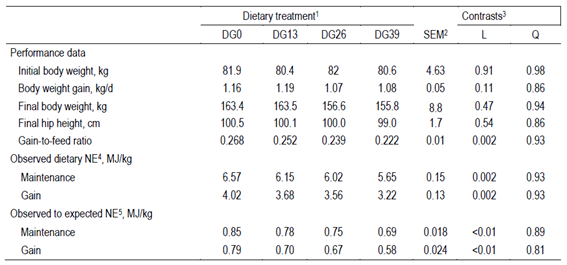
1Concentration of sorghum DG in the diet: 0 (DG0), 130 (DG13), 260 (DG26) or 390 (DG39) g/kg (DM basis). 2SEM: standard error of the mean. 3L, Q: linear and quadratic effect of sorghum DG level (x, %); GF= -0.0012x + 0.2679 (R² = 0.99); NEm = -0.0222x + 6.511 (R² = 0.97); NEg= -0.0205x + 4.038 (R² = 0.96). 4Diet net energy (NE) calculated from animal performance and daily energy requirements21. 5Observed dietary NE with respect to expected diet NE based on tabular values for each ingredient in the diet6.
4. Discussion
Increasing SDDGS level in the diet did not affect the growth of calves, but it increased mean daily DMI (kg/100 kg LW) during the feeding period, with no impact on diet digestibility or animal behavior. As a result, a negative linear reduction was observed in the gain-to-feed ratio. This response partially contradicts our hypothesis given that no optimal level of inclusion maximizing the gain-to-feed ratio was observed.
4.1 Nutritional characteristics of experimental rations
Although diets were formulated for similar CP and ME supply, replacing a mixture of sorghum grain and soybean meal with SDDGS modified the nature of protein and energy sources. Table 1 shows that, compared with DG0, the proportion of rumen undegradable protein (RUP) in dietary CP increased by 24%, while the ADIN concentration almost doubled in DG39. Although ADIN would reflect unavailable protein resulting from heat2, some studies evidenced that in the DG higher ADIN due to heating during drying would not affect the efficiency of the use of RUP 23)(24) . Fat concentration increased by 158%, reaching 65.3 g/kg (DM basis) in DG39. In high-grain diets, this level of fat concentration is expected to have a very low impact on the utilization of other components of the ration 25)(26) ; however, it could reduce intestinal fat digestibility depending on the total daily fat27. Likewise, replacing starch from sorghum grain with digestible fiber from SDDGS increased the aNDFom concentration by 40% while reducing the NFC by 33% (Table 1).
In high-grain diets, varying the source of ME and CP may also affect the site and extent of starch digestion28 as well as the post-ruminal N flow and amino acid supply 7)(21) . These changes could be particularly relevant in such a highly protein-demanding animal category as the early-weaned calf. Diet evaluation using the Beef Cattle Nutrient Requirements Model (BCNRM; Level 1)2 evidenced that, in all four diets, MP supply was the limiting nutrient for higher BW gain compared with ME supply. Increasing SDDGS in the diet resulted in a similar predicted daily supply of MP between treatments, but it modified the proportion of feed protein and microbial protein in the MP. Predicted values for this ratio varied from 580:420 g/kg MP in DG0 to 650:350 g/kg DG39, mainly due to the higher RUP of SDDGS compared with soybean meal (680 vs 441 g/kg CP)2. Although a 22% reduction in microbial protein production was predicted by the model for DG39 compared with DG0, rumen N balance was positive for all rations, varying from +27% of requirements to +3% in DG0 and DG39, respectively. This reduction in microbial production was in response to the lower fermentable energy supply.
4.2 Intake, digestibility, and feeding behavior
As higher levels of SDDGS replaced sorghum grain and soybean meal in the diets of early-weaned beef calves, the DMI (kg/100 kg BW) increased linearly. This result differs from previous research, in which growing cattle exhibited no effect on DMI when fed with SSDGS in the ration at 200 g/kg29 and up to 450 g/kg2, or wet DG from sorghum grain fed up to 290 g/kg30. Variable results among studies on DMI have also been reported with finishing cattle, with much more research having evaluated DG from sorghum. This variation appears to partially be associated with the type of DG and the type of grain in the base diet. A positive linear response in DMI was observed when SDDGS replaced ground dry sorghum grain up to 300 g/kg13, or when wet sorghum DG replaced dry rolled corn at 300 g/kg 9)(31) ; however, no effect was detected when it replaced steam-flaked corn 10)(32) 33.
The increase in DMI together with the variation in nutrient concentration as the SSDGS content in the diet became higher resulted in a significant increase in daily intake of NDF and fats. Compared with DG0, the NDF and fat intake in DG39 increased by 70% and 164%, respectively, whereas the daily intake of NFC reduced by 25%. These changes are expected to modify diet fermentability as starch from sorghum grain in the NFC is reduced28. Pancini and others12 evaluated increasing levels of SDDGS replacing sorghum grain and soybean meal, as in the present study, and reported a significant linear decrease in the ruminal degradability of total DM and CP without affecting NDF degradability (65.6 ± 4.3). It is probable that this lower diet fermentability partially explains the increased response in DMI.
Apparent DMD coefficient was not affected by dietary treatments (0.85, SE 0.03), although a drop in the DMD could be expected due to higher DMI as SDDGS increases in the diet34. The observed results were aligned with those reported by Pancini and others23, who did not observe variations in the DMD (0.84 ± 0.02) when SDDGS was increased up to 450 g/kg in a sorghum-grain-based diet. However, other studies evaluating the use of corn DG for replacing dry rolled corn or steam-flaked corn have observed a negative effect on the DMD34)(35)(36)(37.
Animals’ behavior is expected to vary in response to changes in the nutritional and physical properties of their diet, which in turn may affect feed utilization38. No effect was observed, however, of higher DMI, peNDF concentration, or NDF intake on eating activity, rumination, or resting of the early-weaned beef calf during daytime. Unlike these results, other studies with finishing cattle have observed lower eating activity and a linear increase in intake rate after the first meal in the morning when SDDGS was included up to 450 g/kg in a sorghum-based diet14, or higher eating time when corn dry DG were included at 400 g/kg in a rolled corn-based diet34. In the present study, considering that DMI increased at higher SDDGS levels in the ration and that no differences were detected in eating o rumination activity, an increase in the intake rate (g/min) could be expected, as could a lower rumination time per kg of NDF intake (min/kg). Similar ruminating activity between dietary treatments was not expected in this study based on higher DMI, higher aNDFom intake from forage (equal supply of 150 g/kg of alfalfa hay, Table 1)39, as well as higher peNDF supply18 with increasing SDDGS. Nonetheless, considering that the reported behavior data corresponded to daytime hours, it is possible that the overall 24-hour ruminating activity could have been underestimated, as animals might spend part of the nighttime ruminating40.
4.3 Feed efficiency and NEg
The results partially confirmed the hypothesis of varying feeding values of the diet depending on SDDGS inclusion level between 0 and 390 g/kg (DM basis) when replacing a mixture of sorghum grain and soybean meal; however, no optimum level of SDDGS for maximizing animal performance was detected. Moreover, a linear reduction in the GF ratio with SDDGS concentration in the diet occurred. Our expectation was that a low level of SDDGS in the diet might contribute to improving rumen environment and fermentation, without significantly affecting DMI, hence increasing the GF ratio up to a maximum value. However, it appears that calves needed to increase their intake to compensate for a lower nutritive value of SDDGS. As a result, although no differences were detected in live-weight gain, the observed higher intake and probably a less efficient fermentation, with a higher acetate-to-propionate ratio, contributed to the linear drop of the GF ratio. Studies evaluating the response to SDDGS in growing young calves are quite limited. In growing heavier calves (10 months old, 190 kg), Pancini and others12 also reported a linear decrease in the GF ratio when SDDGS replaced sorghum grain and soybean meal up to 450 g/kg in the ration (DM basis), but no effect was reported when SDDGS was included in a corn-based diet at a low rate (200 g/kg)29. Unlike the present work, Simeone and others30 fed early-weaned beef calves increasing levels of wet DG from sorghum (up to 290 g/kg) in substitution of corn grain and soybean meal, and did not observe any effect on BW gain, DMI, or feed-to-gain ratio (3.6, SE 0.15). Nevertheless, wet DG are expected to have higher nutritive value compared with dry DG 41)(42) . With finishing cattle, no negative effect was observed in gain efficiency when SDDGS replaced sorghum grain up to 300 g/kg13 or 450 g/kg14. However, when SDDGS replaced dry rolled corn grain in the diet at 400 g/kg, a decrease in gain efficiency occurred43.
The observed linear drop in GF when SDDGS was included in the diet of early-weaned calves did not appear to be in response to a variation in the rate of fat tissue accretion, as calves exhibited a similar growth pattern described in terms of BW gain and hip height44. Moreover, other factors that could affect ME partition through increasing maintenance NE requirements, such as feeding behavior, were not affected by dietary treatment. The response in GF, however, agreed with the expected tendency based on the range of variation in peNDF supply in the ration (130 g/kg in DG0 to 190 g/kg in DG39). These values are within the range (120 to 180 g/kg) suggested by Mertens45, where moving to lower levels would contribute to higher gain efficiency (as observed in DG0), whereas moving to higher levels of peNDF in the ration (as observed in DG39) would reduce the incidence of liver abscesses. For early-weaned calves, which will be moved to grazing during the backgrounding phase, feeding them higher peNDF during the post-weaning feedlot through increasing SDDGS level could be a better option.
It is also expected that metabolizable amino acid deficiency affects the animal performance and energy efficiency of early-weaned calves46. Carrasco and others37 evaluated the effect of the inclusion of up to 300 g/kg of corn DG to replace steam-flaked corn in the diet of calf-fed Holstein steers (initial BW 112 kg), and reported a linear increase in BW gain and a quadratic response in GF for the first 126 days on feed, with the maximum value for 200 g/kg of DG in the ration. The authors partially attributed this improvement to differences in metabolizable amino acid supply as DG increased in the ration. In the present study, the predicted first-limiting amino acid according to the BCNRM (Level 1)2 varied depending on the SDDGS level. As SDDGS replaced a higher proportion of sorghum grain and soybean meal, the predicted supply of methionine (the first-limiting amino acid in DG0, −45% of requirements) increased, whereas lysine (the second-limiting amino acid in DG0) decreased, becoming the first-limiting amino acid in DG39 (−39% of requirements) followed by histidine.
As expected, the response in GF was aligned with a linear reduction in calculated NEm and NEg47. The observed reduction in NEg as the diet SDDGS content increased could have been the result of a differential supply of ME and the efficiency of use of ME. On the one hand, the highest NFC and starch concentration coming from sorghum grain, as in DG0, would promote a more efficient fermentation pattern, characterized by a lower acetate-to-propionate ratio concentration 37)(48) , and eventually by a shift in the site of digestion of a higher quantity of starch to the small intestine, thus improving metabolic efficiency28. On the other hand, as SDDGS increases in the diet, switching from starch to a higher digestible NDF and a higher fat concentration could result in an increased acetate-to-propionate concentration ratio and reduced fat intestinal digestibility, which would negatively affect diet NEg27. Zinn and others49 evaluated 40, 80, and 120 g/kg of supplemental fat in the diet of crossbred steers (245 kg), and observed a depression in gain efficiency and dietary NEg. They concluded that optimal growth would be expected when the total lipid intake remains below 1.6 g/kg BW. In our study, with early-weaned calves, the total lipid intake expressed in g/kg of BW was 1.1, 1.9, 2.3, and 3.1 for DG0, DG13, D26, and DG39, respectively, which could partially explain the observed lower dietary NEg as SDDGS was higher in the diet. Based on the prediction equation for fat intestinal digestion (FID; % = 87.56 - 8.59 fat intake, g/kg BW)50, the calculated values were 76%, 69%, 66%, and 59% for DG0, DG13, DG26, and DG39, respectively. Pancini and others23 also observed a decrease in EE digestibility as SDDGS increased up to 450 g/kg in the diet of lot-fed calves (180 kg BW), without affecting NDF or CP total tract digestibility.
Previous research with finishing cattle has already demonstrated that the inclusion of SDDGS negatively affects diet NEg concentration in corn (−7%, 400 g/kg)43 but not in sorghum grain-based diets (−0.3%, 450 g/kg)14. For early-weaned beef calves, the present work evidenced a higher negative impact. Compared with DG0, the NEg value in DG13, DG26, and DG39 exhibited a reduction of 10%, 13%, and 29%, respectively. Dietary NEm and NEg in DG0 were below the expected values according to the diet composition and NE values of ingredients reported by the feeding standards (Table 4), with observed-to-expected ratios of 0.84 and 0.78, respectively. These differences were even larger as the SDDGS level increased in the ration. It is probable that reported NE values for DG plus soluble dry6 overestimated actual NE content of the SDDGS.
5. Conclusions
Feeding early-weaned beef calves increasing levels of SDDGS as a protein/energy source in a high-grain diet (up to 390 g/kg) does not affect BW gain, but it did linearly reduce gain efficiency. Replacing sorghum grain and soybean meal with SDDGS reduces dietary NEg, evidencing lower feeding values for SDDGS compared with the mixture it replaces.
















